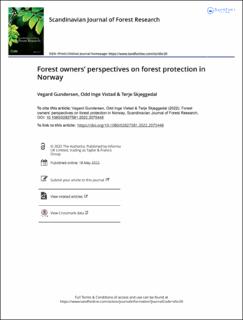Forest owners' perspectives on forest protection in Norway
Peer reviewed, Journal article
Published version

Åpne
Permanent lenke
https://hdl.handle.net/11250/2997908Utgivelsesdato
2022Metadata
Vis full innførselSamlinger
- Publikasjoner fra CRIStin - NINA [2364]
- Scientific publications [1392]
Originalversjon
10.1080/02827581.2022.2075448Sammendrag
Forest protection in nature reserves in Norway relies on the voluntary participation of forest owners. While the national forest protection program has been a success since its start in early 1990s, by 2020 the national forest protection authorities were only halfway to reaching their goal of protecting 10% all forest area. We examined attitudes towards forest protection in general and towards different protection modes using surveys of forest owners between 2003 and 2010. Our analysis is based on a comprehensive comparison between a random sample of forest owners (n = 647), forest owners who participated in voluntary conservation (n = 126) and forest owners involved in the government-led coniferous forest protection program (n = 142). Only about 10% of forest owners involved in voluntary protection processes are either quite or very unhappy with the process, while 75% of forest owners involved in government-led protection were either quite or very unhappy with the process. Moreover, forest owners who had experience with the voluntary protection program were largely satisfied with the results. We discuss forest owners’ attitudes to forest protection in general, and possible reasons for the differences in attitudes between compulsory protection and voluntary protection. We conclude that voluntary protection has great potential to fulfill the last 5% area goal for forest protection in Norway, with some improvements in the process. Biodiversity conservation; landowners; nature reserves; policy implementation; participation process
